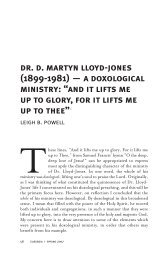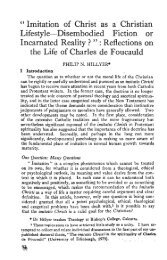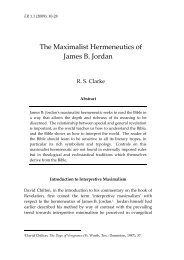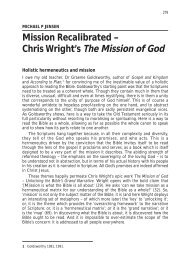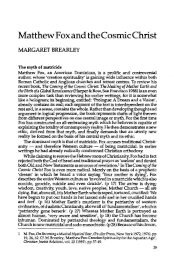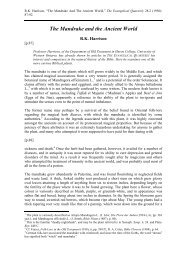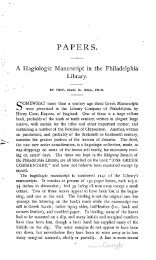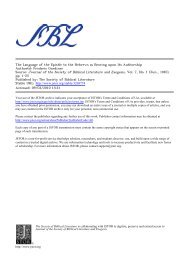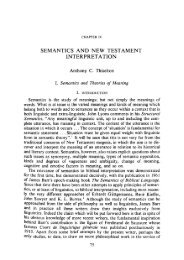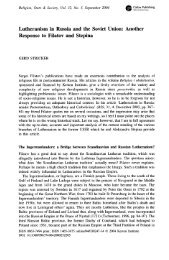Ancient Orient and Old Testament - BiblicalStudies.org.uk
Ancient Orient and Old Testament - BiblicalStudies.org.uk
Ancient Orient and Old Testament - BiblicalStudies.org.uk
You also want an ePaper? Increase the reach of your titles
YUMPU automatically turns print PDFs into web optimized ePapers that Google loves.
K.A. Kitchen, <strong>Ancient</strong> <strong>Orient</strong> <strong>and</strong> <strong>Old</strong> <strong>Testament</strong>. London: Inter-Varsity Press, 1966. Hbk. pp.191.<br />
[p.47]<br />
For early Mesopotamian expeditions into the Westl<strong>and</strong> like that of Genesis 14, one may in<br />
some measure compare the texts about Sargon of Akkad <strong>and</strong> Naram-Sin (c. twenty-fourth to<br />
twenty-third centuries BC) invading to Amanus in Syria <strong>and</strong> possibly further north-west, 55<br />
mention of relations with Didanum (between Euphrates <strong>and</strong> Syria?) 56 during the Third<br />
Dynasty of Ur (c. twenty-second to twenty-first centuries BC), 57 <strong>and</strong> the expedition of<br />
Shamshi-Adad I of Assyria to Lebanon (nineteenth or eighteenth century BC). 58<br />
The overthrow of the cities of the plain (including particularly Sodom <strong>and</strong> Gomorrah) by<br />
seismic movement <strong>and</strong> conflagration (Gn. 19) 59 cannot be independently dated at present;<br />
their ruins are apparently under the Dead Sea, <strong>and</strong> the neighbouring site of Bab-edh-Dhra<br />
may have come to an end in the twenty-first century BC before they did. 60<br />
(b) Indications of Date in the Narratives<br />
I. Power-alliances between Mesopotamian states (Gn. 14) are typical for c. 2000-1750 BC (see<br />
above, pp. 45 f.).<br />
[p.48]<br />
2. The personal names of the Patriarchs <strong>and</strong> their families can be directly compared with identical or<br />
similarly formed names in Mesopotamian <strong>and</strong> Egyptian 61 documents of the twentieth to eighteenth<br />
101; military character of Umman-m<strong>and</strong>a (with dubious ‘Indo-germanisch’ speculations), F. Cornelius, Iraq 25<br />
(1963), pp. 167-170. Later, cf. D. J. Wiseman, Chronicles of Chaldaean Kings, 1956, pp. 15, 16, 18, 81, <strong>and</strong> S.<br />
Smith, Isaiah XL-LV, 1944, pp. 127-128. For the word goyim, ‘nations’, cf. E. A. Speiser, JBL 79 (1960), pp.<br />
157-163, <strong>and</strong> Genesis (Anchor Bible), 1964, pp. 107-108; JAOS 72 (1952), pp. l00-101 <strong>and</strong> n. 36.<br />
55 See Gadd, CAH 2 , I: 1g (Dynasty of Agade <strong>and</strong> Gutian Invasion), 1963, pp. 10-16, 27-29. From a still earlier<br />
period, note the discovery of archaic Sumerian tablets in a Neolithic site in S. Rumania(!), although probably<br />
not brought by Sumerians so far (N. Vlassa, Dacia, (NF), 7 (1963), pp. 485-494, esp. 490); my thanks go to<br />
Frau I. Fuhr for this reference.<br />
56 So I. J. Gelb, JCS 15 (1960), p. 30. For Sargon of Akkad <strong>and</strong> IahdunLim of Mari in the West, cf. Malamat in<br />
Studies in Honor of Benno L<strong>and</strong>sberger, 1965 (Assyriological Studies, 16), pp. 365-373.<br />
57 Gelb, loc. cit.; Albright, in Geschichte <strong>and</strong> Alles <strong>Testament</strong> (FS Alt), 1953, pp. 11-12. For links between<br />
Byblos <strong>and</strong> the Third Dynasty of Ur, cf. E. Sollberger, AfO 19 (1960), pp. 120 ff.<br />
58 ANET, p. 274b; Kupper, CAH 2 , II: I (N. Mesopotamia <strong>and</strong> Syria), 1963, p. 5. On the realism of the<br />
expedition in Gn. 14, cf. de Vaux, RB 55 (1948) pp. 328, 330-331 (=Die hebr. Patr., 1961, pp. 35, 37-38) The<br />
opinion of some <strong>Old</strong> <strong>Testament</strong> scholars that Gn. 14 is merely a late midrash (e.g., ZAW 74 (1962), p. 116)<br />
wholly fails to account for the authentic early detail of power-alliances pointed out above.<br />
59 See J. P. Harl<strong>and</strong>, BA 5 (1942), pp. 17-32, <strong>and</strong> esp. BA 6 (1943), pp. 41-54. Popular presentation in W.<br />
Keller, The Bible as History, 1956, pp. 93 - 97.<br />
60 Cf. earlier Albright, BASOR 14 (1924), pp. 5-9, AASOR, Vol. 6, 1926, pp. 58-62, 66; <strong>and</strong> now, BASOR 163<br />
(1961), p. 51 n. 73 with BASOR 95 (1944) p. 9 n. 18.<br />
61 The so-called Execration Texts. Earlier series in K. Sethe, Die Ächtung feindlicher Fürsten, Volker <strong>and</strong> Dinge auf<br />
altägyptischen Tongefässscherben des mittleren Reichs, 1926; cf. Albright, JPOS 8 (1928), pp. 223-256 <strong>and</strong><br />
references. Later series in G. Posener, Princes et Pays d’Asie et de Nubie, 1940, cf. Albright, BASOR 81 (1941), pp.<br />
16-21, <strong>and</strong> BASOR 83 (1941), pp. 30-36 <strong>and</strong> references. Cf. also W. Helck, Die Beziehungen Ägyptens zu<br />
Vorderasien im 3. und 2 . Jahrtausend v. Chr., 1962, pp. 49-68, <strong>and</strong> further references in H. B. Huffmon, Amorite




